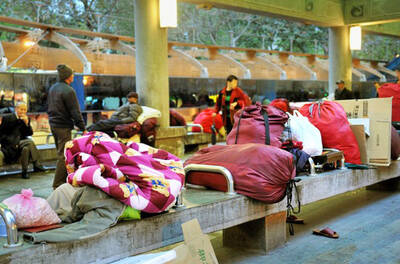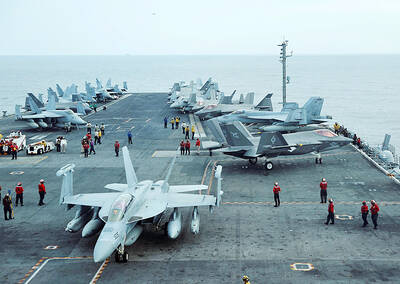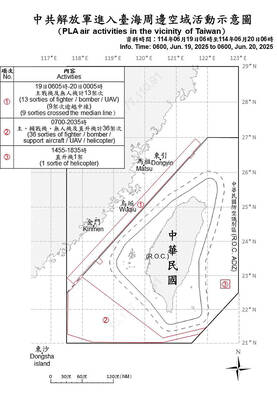Tourists are advised to wear shoes with at least a 1cm heel in accordance with their weight and foot shape to avoid excessive pressure on their heels from walking long distances and to avoid Achilles tendonitis, a doctor has said.
Tsai Yung-yuh (蔡永裕), head of the rehabilitation center at Cheng Ching General Hospital’s Chung Kang Branch, said a group of wealthy women who had spent days walking in flat-soled shoes during a trip to Europe, recently visited his outpatient service.
They had not been wearing high heels, but the flats they wore during their journey were largely made with an attenuate heel that caused severe pain after walking long distances, Tsai added.
“Wearing the wrong type of shoes during a trip can be a nightmare. While some believe that flats are a better option [than high heels], what really defines a pair of ideal walking shoes is the height of its heel,” the doctor said.
Tsai added that in most circumstances, people’s heels make contact with the ground first when walking, putting most of the pressure on that part of the foot.
Extra insoles added to the flats are insufficient to absorb the pressure exerted on the foot, Tsai said, adding that walking in such footwear would cause continued pressure on the heels. If this is repeated often enough, it results in the lengthening of the Achilles tendon, which causes tendonitis and soreness.
People who are obese — classified as having a body mass index (BMI) of 25 or above — should pay more attention when selecting footwear, Tsai said.
Because of their body weight, overweight people may be susceptible to greater physical harm with a higher chance of injuring their tendons if walking in flats or uncomfortable shoes, he said.
“Choosing shoes is an art and a science. In addition to looking right and being lightweight, the best shoes should have a heel of at least 1cm in height and be the best fit for one’s foot shape and weight,” Tsai said.

A year-long renovation of Taipei’s Bangka Park (艋舺公園) began yesterday, as city workers fenced off the site and cleared out belongings left by homeless residents who had been living there. Despite protests from displaced residents, a city official defended the government’s relocation efforts, saying transitional housing has been offered. The renovation of the park in Taipei’s Wanhua District (萬華), near Longshan Temple (龍山寺), began at 9am yesterday, as about 20 homeless people packed their belongings and left after being asked to move by city personnel. Among them was a 90-year-old woman surnamed Wang (王), who last week said that she had no plans

China might accelerate its strategic actions toward Taiwan, the South China Sea and across the first island chain, after the US officially entered a military conflict with Iran, as Beijing would perceive Washington as incapable of fighting a two-front war, a military expert said yesterday. The US’ ongoing conflict with Iran is not merely an act of retaliation or a “delaying tactic,” but a strategic military campaign aimed at dismantling Tehran’s nuclear capabilities and reshaping the regional order in the Middle East, said National Defense University distinguished adjunct lecturer Holmes Liao (廖宏祥), former McDonnell Douglas Aerospace representative in Taiwan. If

TO BE APPEALED: The environment ministry said coal reduction goals had to be reached within two months, which was against the principle of legitimate expectation The Taipei High Administrative Court on Thursday ruled in favor of the Taichung Environmental Protection Bureau in its administrative litigation against the Ministry of Environment for the rescission of a NT$18 million fine (US$609,570) imposed by the bureau on the Taichung Power Plant in 2019 for alleged excess coal power generation. The bureau in November 2019 revised what it said was a “slip of the pen” in the text of the operating permit granted to the plant — which is run by Taiwan Power Co (Taipower) — in October 2017. The permit originally read: “reduce coal use by 40 percent from Jan.

‘SPEY’ REACTION: Beijing said its Eastern Theater Command ‘organized troops to monitor and guard the entire process’ of a Taiwan Strait transit China sent 74 warplanes toward Taiwan between late Thursday and early yesterday, 61 of which crossed the median line in the Taiwan Strait. It was not clear why so many planes were scrambled, said the Ministry of National Defense, which tabulated the flights. The aircraft were sent in two separate tranches, the ministry said. The Ministry of Foreign Affairs on Thursday “confirmed and welcomed” a transit by the British Royal Navy’s HMS Spey, a River-class offshore patrol vessel, through the Taiwan Strait a day earlier. The ship’s transit “once again [reaffirmed the Strait’s] status as international waters,” the foreign ministry said. “Such transits by